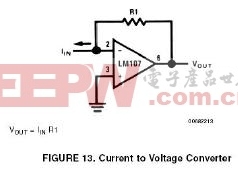电流—电压转换电路:The Current-to-Volta
电流—电压转换电路:The Current-to-Voltage Converter
Current may be measured in two ways with an operational amplifier. The current may be converted into a voltage with a resistor and then amplified or the current may be injected directly into a summing node. Converting into voltage is undesirable for two reasons: first, an impedance is inserted into the measuring line causing an error; second, amplifier offset voltage is also amplified with a subsequent loss of accuracy. The use of a current-to-voltage transducer avoids both of these problems. The current-to-voltage transducer is shown in Figure 13. The input current is fed directly into the summing node and the amplifier output voltage changes to extract the same current from the summing node through R1. The scale factor of this circuit is R1 volts per amp. The only conversion error in this circuit is Ibias which is summed algebraically with IIN. This basic circuit is useful for many applications other than current measurement. It is shown as a photocell amplifier in the following section. The only design constraints are that scale factors must be chosen to minimize errors due to bias current and since voltage gain and source impedance are often indeterminate (as with photocells) the amplifier must be compensated for unity-gain operation. Valuable techniques for bias current compensation are contained in Reference 5.

利用OP进行电流测量,有两种方法。利用电流在电阻上的压降,再进行电压放大,或者直接将电流注入OP的求和点。这样的电路,转换得到的电压信号可以直接加在OP放大的输入端上。这种转换方式有两个不妥的地方:首先电阻的加入将会破坏电路原来的状态,带来测量上的误差。其次OP的失调电压也会被OP自己放大,并加到测量的输出结果中去。使用电流——电压转换电路可以避免上面两点不足。电路结构如图13。输入电流直接接入OP的求和点(反相输入端),由KCL定理可知,OP输出端将通过R1向这个点(求和点)提供同样大小的电流以达到平衡,电路的增益(这里叫跨导似乎更好——译者)由R1决定。本电路唯一的误差来源于输入偏置电流Ibias,该电流作为误差,和输入电流IIN做了代数叠加。
电流——电压转换电路的用途不限于电流的测量上,还可以用在例如后面的光电池放大电路中。在设计中唯一需要注意的是电路的增益的选择,增益的选择要做到使得偏置电流所带来的误差达到最小。由于信号源的电压和内阻通常是不恒定的,OP必须对单位增益做补偿。



评论